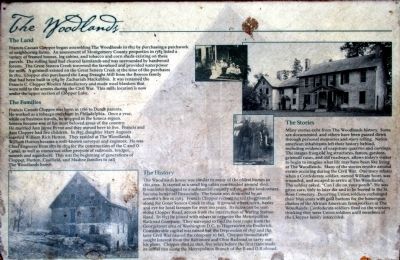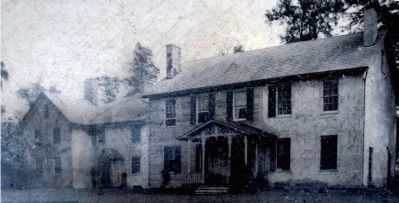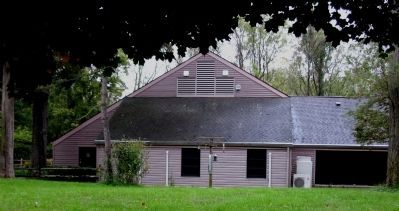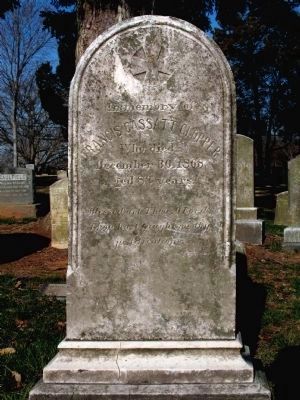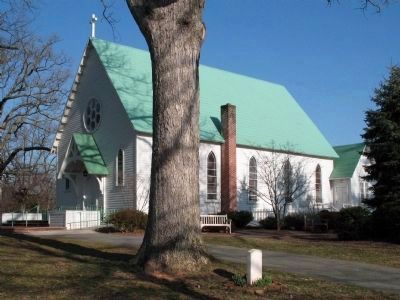Gaithersburg in Montgomery County, Maryland — The American Northeast (Mid-Atlantic)
The Woodlands
The Land
Francis Cassatt Clopper began assembling The Woodlands in 1812 by purchasing a patchwork of neighboring farms. An assessment of Montgomery County properties in 178 listed a variety of framed houses, log cabins, and tobacco and corn sheds existing on these parcels. The rolling land had cleared farmlands and was surrounded by hardwood forests. The Great Seneca Creek traversed the farmland and provided waterpower for mills. A gristmill existed on Great Seneca Creek at the time of the purchases in 1812. Clopper also purchased the Long Draught Mill from the Benson family that had been built in 1784 by Zachariah Macubbin. It was renamed the Francis C. Clopper Woolen Manufactory and made wool blankets that were sold to armies during the Civil War. This mills location is now under the upper section of Clopper Lake.
The Families
Francis Cassatt Clopper was born in 1786 to Dutch parents. He worked as a tobacco merchant in Philadelphia. Once a year, while on business travels, he stopped in the Seneca region. Seneca became one of the most beloved areas of the country. He married Ann Jayne Byrne and they moved here to live. Francis and Ann Clopper has five children. In 1855, daughter Mary Agusta married William Rich Hutton. They resided at the Woodlands, William Hutton became a well-known surveyor and engineer. He was Chief Engineer from 1871 to 1874 for the construction of the C and O Canal; as well as numerous other projects of railroads, bridges, tunnels and aqueducts. This was the beginning of generations of Clopper Hutton, Caulfield, and Madine families to call The Woodlands home.
The History
The Woodlands house was similar to many of the older houses in this area. It started as a small log cabin constructed around 1800. It was later enlarged to a substantial country estate, as the landowners became better off financially. The house was destroyed by an arsonists fire in 1963. Francis Clopper reconstructed the gristmill long the Great Seneca Creek in 1834. It ground wheat, corn, barley and rye for local farmers for over 100 years. Its ruins can be seen along Clopper Road, across from the intersection of Waring Station Road. In 1853 he joined with others to organize the Metropolitan Railroad Company. They surveyed to find the best route from the Georgetown area of Washington D.C. to Hagerstown via Frederick. Considerable capital was raised but he Depression on 1857 and later Civil War caused the company to fail. Clopper immediately sought interest from the Baltimore and Ohio Railroad to carry out his plans. Clopper died in 1868, five years before the first train made the initial run along the Metropolitan Branch of the B and O Railroad.
The
Stories
Many stories exist from The Woodlands history. Some documented, and others have been passed down through personal memories and story telling. Native american inhabitants left their history behind, including the evidence of soapstone quarries and carvings. The images from old log structures, fences gardens gristmill ruins and old roadways, allows (sic) today's visitor to begin to imagine what life may have been like living in The Woodlands. Many of the stories revolve around events occurring during the Civil War. One story related when a Confederate soldier named William Scott, was wounded, and escaped to arrive at The Woodlands . The Soldier asked, "Can I die on your porch". He was given care, only to later die and to be buried in the St. Rose Cemetery. Deserting Union soldiers exchanged their blue coast with gold buttons for the homespun clothes of African American farm workers at The Woodlands. Confederate soldiers fired on workers thinking they were Union soldiers until members of the Clopper family interceded.
Topics. This historical marker is listed in these topic lists: African Americans • War, US Civil. A significant historical year for this entry is 1812.
Location. 39° 8.907′ N, 77° 15.008′ W. Marker is in Gaithersburg, Maryland, in Montgomery County. Marker can be reached from the intersection of Seneca Creek Road
and Clopper Road (Maryland Route 117), on the right when traveling west. Located in front of the Seneca Creek State Park Visitor's Center. Touch for map. Marker is at or near this postal address: 11950 Clopper Road, Gaithersburg MD 20878, United States of America. Touch for directions.
Other nearby markers. At least 8 other markers are within 3 miles of this marker, measured as the crow flies. Grusendorf Log House (approx. 0.2 miles away); The Musser Cemetery (approx. one mile away); Middlebrook Mills (approx. 1.7 miles away); The Germantown Bank (approx. 2.1 miles away); Liberty Mill (approx. 2.1 miles away); Reflections of Old Germantown (approx. 2.1 miles away); Railway Bed (approx. 2˝ miles away); Chestnut/Meem Historic District (approx. 2˝ miles away). Touch for a list and map of all markers in Gaithersburg.
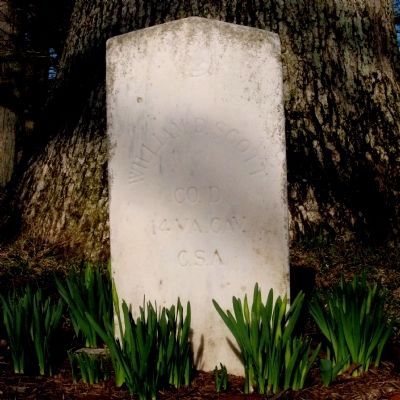
Photographed By Allen C. Browne, March 11, 2006
5. Grave of William Scott, in front of St. Rose of Lima Church
Co. D
14 Va. Cav.
CSA
Credits. This page was last revised on September 22, 2019. It was originally submitted on November 27, 2013, by Allen C. Browne of Silver Spring, Maryland. This page has been viewed 1,115 times since then and 47 times this year. Photos: 1, 2, 3, 4, 5, 6. submitted on November 27, 2013, by Allen C. Browne of Silver Spring, Maryland. • Bernard Fisher was the editor who published this page.
